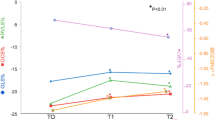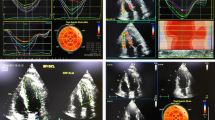Abstract
Objective
Anthracycline chemotherapeutic agents have significant cardiotoxicity. The present study emphasized the effect of anthracycline chemotherapy drugs on left ventricular (LV) myocardial stiffness in breast cancer patients by measuring the intrinsic wave velocity propagation (IVP), and evaluating the potential clinical value of IVP in detecting early LV diastolic function impairment.
Methods
A total of 68 newly diagnosed breast cancer patients, who were treated with anthracycline-based chemotherapy, were analyzed. Transthoracic echocardiography was performed at baseline (T0), and after 1, 2, 3, 4 and 8 chemotherapeutic cycles (T1, T2, T3, T4 and T5, respectively). Then, the IVP, LV strain parameters [global longitudinal strain (GLS), longitudinal peak strain rate at systole (LSRs), longitudinal peak strain rate at early diastole (LSRe), longitudinal peak strain rate at late diastole (LSRa), and the E/LSRe ratio], and conventional echocardiographic parameters were obtained and further analyzed. A relative reduction of >15% in GLS was considered a marker of early LV subclinical dysfunction.
Results
Compared to the T0 stage, IVP significantly increased at the T1 stage. However, there were no significant changes in GLS, LSRs, or LSRe between the T0 and T1 stages. These parameters significantly decreased from the T2 stage. LSRa started to significantly decrease at the T5 stage, and the E/LSRe ratio started to significantly increase at the T3 stage (all P<0.05). At the T0 stage, IVP (AUC=0.752, P<0.001) had a good predictive value for LV subclinical dysfunction after chemotherapy.
Conclusions
IVP is a potentially sensitive parameter for the early clinical assessment of anthracycline-related cardiac diastolic impairment.
Similar content being viewed by others
References
Wilkinson L, Gathani T. Understanding breast cancer as a global health concern. Br J Radiol, 2022,95(1130):20211033
Berry GJ, Jorden M. Pathology of radiation and anthracycline cardiotoxicity. Pediatr Blood Cancer, 2005,44(7):630–637
Piegari E, De Angelis A, Cappetta D, et al. Doxorubicin induces senescence and impairs function of human cardiac progenitor cells. Basic Res Cardiol, 2013,108(2):334
Molinaro M, Ameri P, Marone G, et al. Recent Advances on Pathophysiology, Diagnostic and Therapeutic Insights in Cardiac Dysfunction Induced by Antineoplastic Drugs. Biomed Res Int, 2015,2015:138148
McGowan JV, Chung R, Maulik A, et al. Anthracycline Chemotherapy and Cardiotoxicity. Cardiovasc Drugs Ther, 2017,31(1):63–75
Gulati M, Mulvagh SL. The connection between the breast and heart in a woman: Breast cancer and cardiovascular disease. Clin Cardiol, 2018,41(2):253–257
Upshaw JN, Finkelman B, Hubbard RA, et al. Comprehensive Assessment of Changes in Left Ventricular Diastolic Function With Contemporary Breast Cancer Therapy. JACC Cardiovasc Imaging, 2020,13(1 Pt 2):198–210
Lipshultz SE, Adams MJ, Colan SD, et al. Longterm cardiovascular toxicity in children, adolescents, and young adults who receive cancer therapy: pathophysiology, course, monitoring, management, prevention, and research directions: a scientific statement from the American Heart Association. Circulation, 2013,128(17):1927–1995
Pfeffer MA, Shah AM, Borlaug BA. Heart Failure With Preserved Ejection Fraction In Perspective. Circ Res, 2019,124(11):1598–1617
Pislaru C, Pellikka PA, Pislaru SV. Wave propagation of myocardial stretch: correlation with myocardial stiffness. Basic Res Cardiol, 2014,109(6):438
Pislaru C, Alashry MM, Thaden JJ, et al. Intrinsic Wave Propagation of Myocardial Stretch, A New Tool to Evaluate Myocardial Stiffness: A Pilot Study in Patients with Aortic Stenosis and Mitral Regurgitation. J Am Soc Echocardiogr, 2017,30(11):1070–1080
Zhang J, Deng Y, Tang Q, et al. Evaluation of Myocardial Stiffness in Hypertensive Patients by Intrinsic Wave Propagation of the Myocardial Stretch. Ultrasound Med Biol, 2020,46(10):2683–2691
Nagueh SF, Smiseth OA, Appleton CP, et al. Recommendations for the Evaluation of Left Ventricular Diastolic Function by Echocardiography: An Update from the American Society of Echocardiography and the European Association of Cardiovascular Imaging. J Am Soc Echocardiogr, 2016,29(4):277–314
Celutkiene J, Pudil R, Lopez-Fernandez T, et al. Role of cardiovascular imaging in cancer patients receiving cardiotoxic therapies: a position statement on behalf of the Heart Failure Association (HFA), the European Association of Cardiovascular Imaging (EACVI) and the Cardio-Oncology Council of the European Society of Cardiology (ESC). Eur J Heart Fail, 2020,22(9):1504–1524
Lyon AR, Lopez-Fernandez T, Couch LS, et al. 2022 ESC Guidelines on cardio-oncology developed in collaboration with the European Hematology Association (EHA), the European Society for Therapeutic Radiology and Oncology (ESTRO) and the International Cardio-Oncology Society (IC-OS). Eur Heart J, 2022,43(41):4229–4361
Zamorano JL, Lancellotti P, Rodriguez Munoz D, et al. 2016 ESC Position Paper on cancer treatments and cardiovascular toxicity developed under the auspices of the ESC Committee for Practice Guidelines: The Task Force for cancer treatments and cardiovascular toxicity of the European Society of Cardiology (ESC). Eur Heart J, 2016,37(36):2768–2801
Cardinale D, Colombo A, Bacchiani G, et al. Early detection of anthracycline cardiotoxicity and improvement with heart failure therapy. Circulation, 2015,131(22):1981–1988
Gulati G, Zhang KW, Scherrer-Crosbie M, et al. Cancer and cardiovascular disease: the use of novel echocardiography measures to predict subsequent cardiotoxicity in breast cancer treated with anthracyclines and trastuzumab. Curr Heart Fail Rep, 2014,11(4):366–373
Chan J, Shiino K, Obonyo NG, et al. Left Ventricular Global Strain Analysis by Two-Dimensional Speckle-Tracking Echocardiography: The Learning Curve. J Am Soc Echocardiogr, 2017,30(11):1081–1090
Charbonnel C, Convers-Domart R, Rigaudeau S, et al. Assessment of global longitudinal strain at low-dose anthracycline-based chemotherapy, for the prediction of subsequent cardiotoxicity. Eur Heart J Cardiovasc Imaging, 2017,18(4):392–401
Timóteo AT, Moura Branco L, Filipe F, et al. Cardiotoxicity in breast cancer treatment: What about left ventricular diastolic function and left atrial function? Echocardiography, 2019,36(10):1806–1813
Sritharan HP, Delaney GP, Lo Q, et al. Evaluation of traditional and novel echocardiographic methods of cardiac diastolic dysfunction post radiotherapy in breast cancer. Int J Cardiol, 2017,243:204–208.
Li VW, Cheuk DK, Cheng FW, et al. Myocardial stiffness as assessed by diastolic wall strain in adult survivors of childhood leukaemias with preserved left ventricular ejection fraction. Eur Heart J Cardiovasc Imaging, 2017,18(4):451–458
Villemain O, Correia M, Mousseaux E, et al. Myocardial Stiffness Evaluation Using Noninvasive Shear Wave Imaging in Healthy and Hypertrophic Cardiomyopathic Adults. JACC Cardiovasc Imaging, 2019,12(7 Pt 1):1135–1145
Ellims AH, Shaw JA, Stub D, et al. Diffuse myocardial fibrosis evaluated by post-contrast t1 map** correlates with left ventricular stiffness. J Am Coll Cardiol, 2014,63(11):1112–1118
Pislaru C, Ionescu F, Alashry M, et al. Myocardial Stiffness by Intrinsic Cardiac Elastography in Patients with Amyloidosis: Comparison with Chamber Stiffness and Global Longitudinal Strain. J Am Soc Echocardiogr, 2019,32(8):958–968.e4
De Jesus T, Alashry MM, Padang R, et al. Intrinsic cardiac elastography in patients with primary mitral regurgitation: predictive role after mitral valve repair. Eur Heart J Cardiovasc Imaging, 2021,22(8):912–921
Serrano JM, González I, Del Castillo S, et al. Diastolic Dysfunction Following Anthracycline-Based Chemotherapy in Breast Cancer Patients: Incidence and Predictors. Oncologist, 2015,20(8):864–872
Author information
Authors and Affiliations
Corresponding author
Ethics declarations
The authors declare that there is no conflict of interest with any financial organization or corporation or individual that can inappropriately influence this work.
Additional information
The study was funded in part by the Hubei Province Health and Famliy Planning Scientific Research Project (No. WJ2023M011) and the Department of Finance of Hubei Province (No. 3890750).
Rights and permissions
About this article
Cite this article
Huang, X., Fan, Xy., Cheng, Q. et al. Intrinsic Wave Velocity Propagation: A Novel Parameter for Assessing the Effect of Anthracycline Chemotherapy Agents on Cardiac Diastolic Function in Breast Cancer Patients. CURR MED SCI 43, 1229–1237 (2023). https://doi.org/10.1007/s11596-023-2807-5
Received:
Accepted:
Published:
Issue Date:
DOI: https://doi.org/10.1007/s11596-023-2807-5




